Answered step by step
Verified Expert Solution
Question
1 Approved Answer
OCCYPATIONAL HEALTH AND SAFETY 1. What are the three basic rights that apply to all Canadian employees with regards to Occupational Health & Safety?


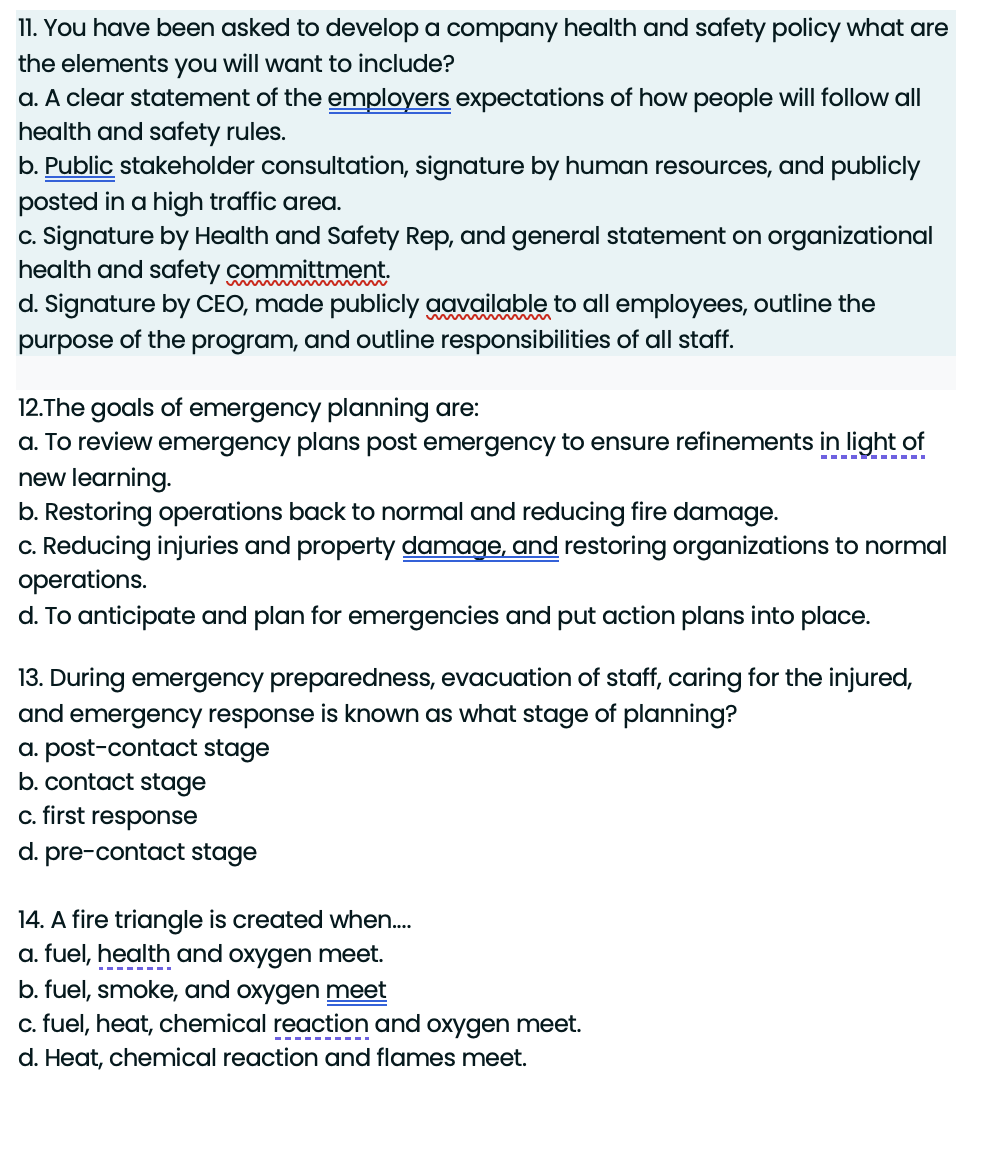
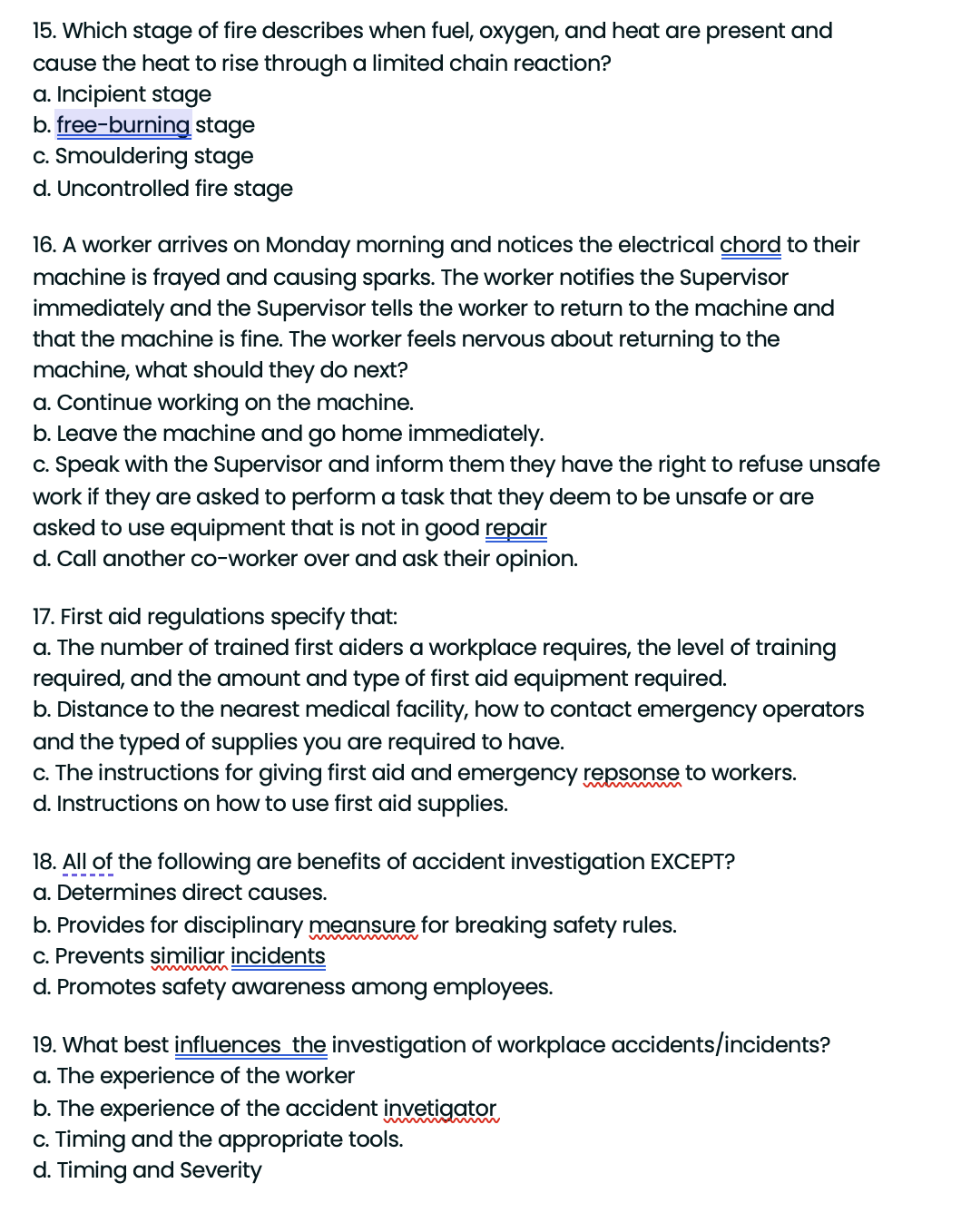
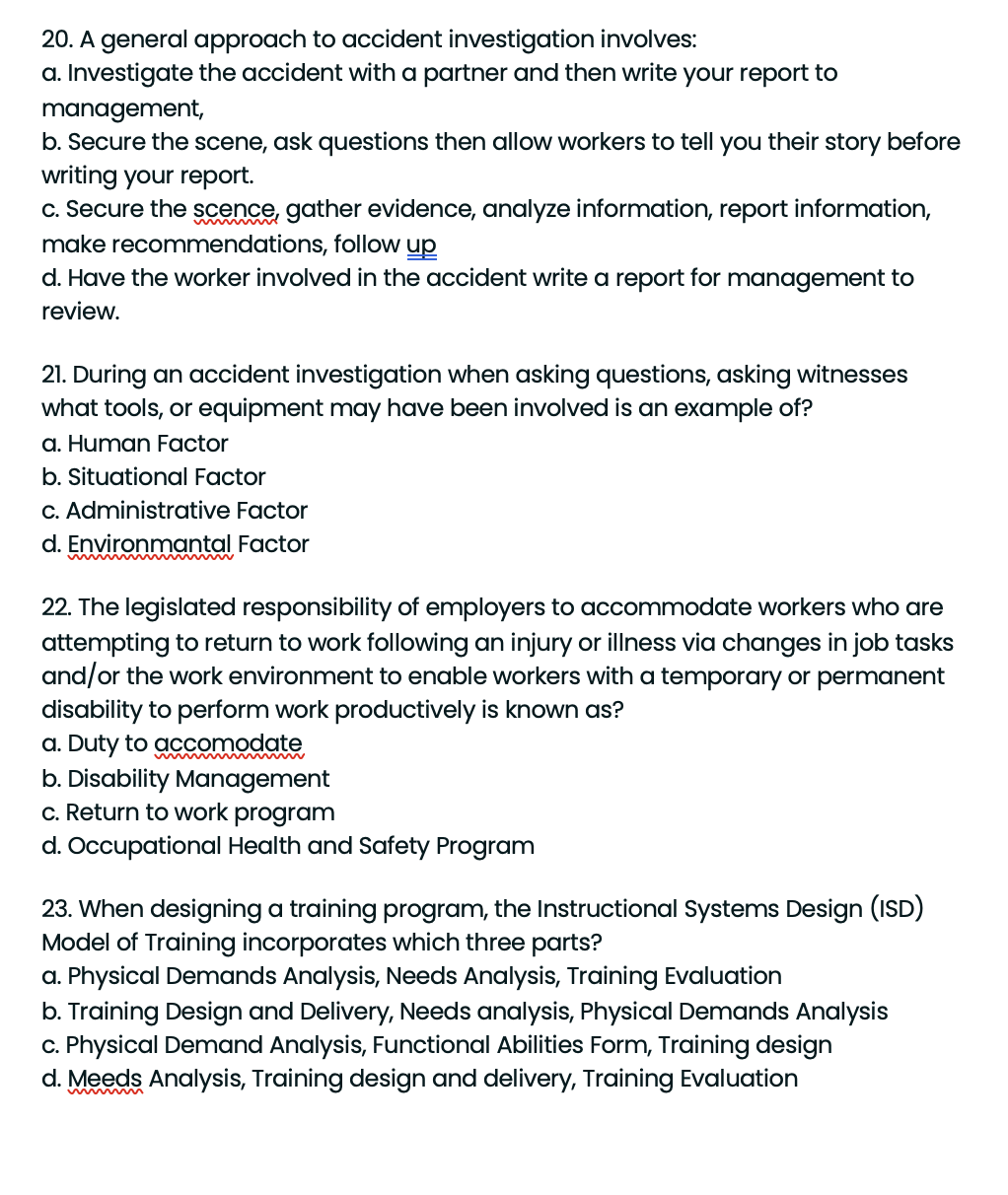
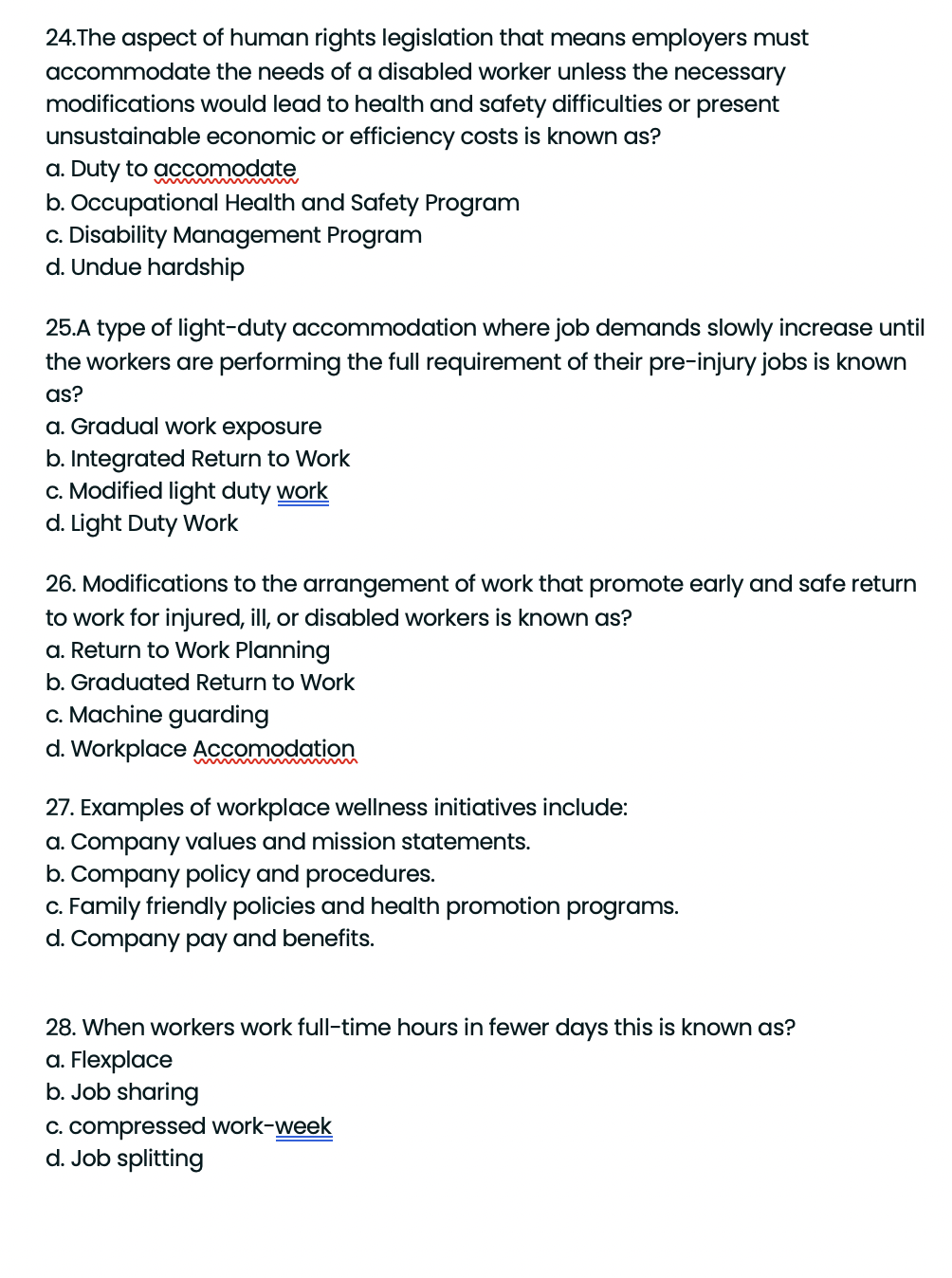
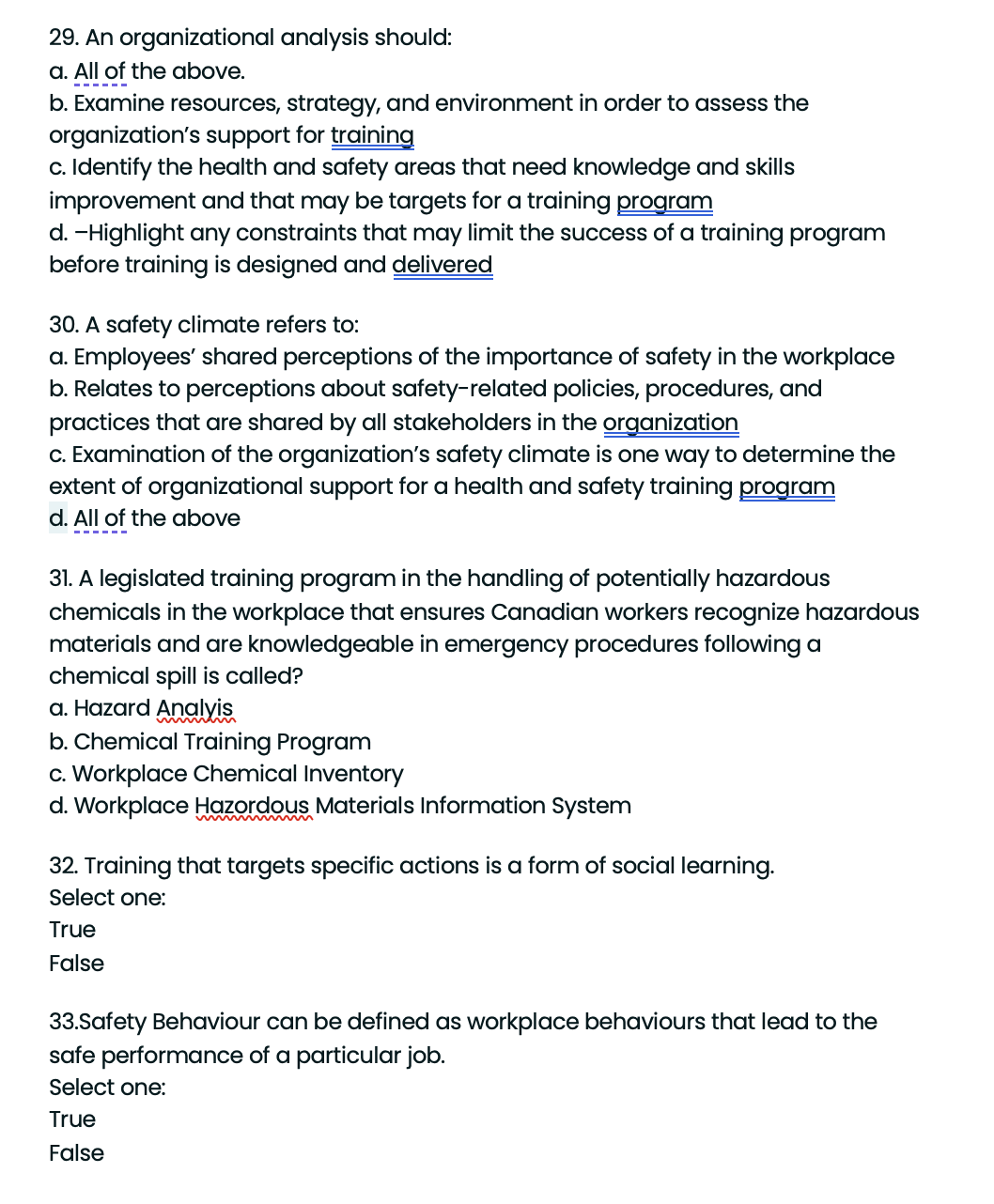
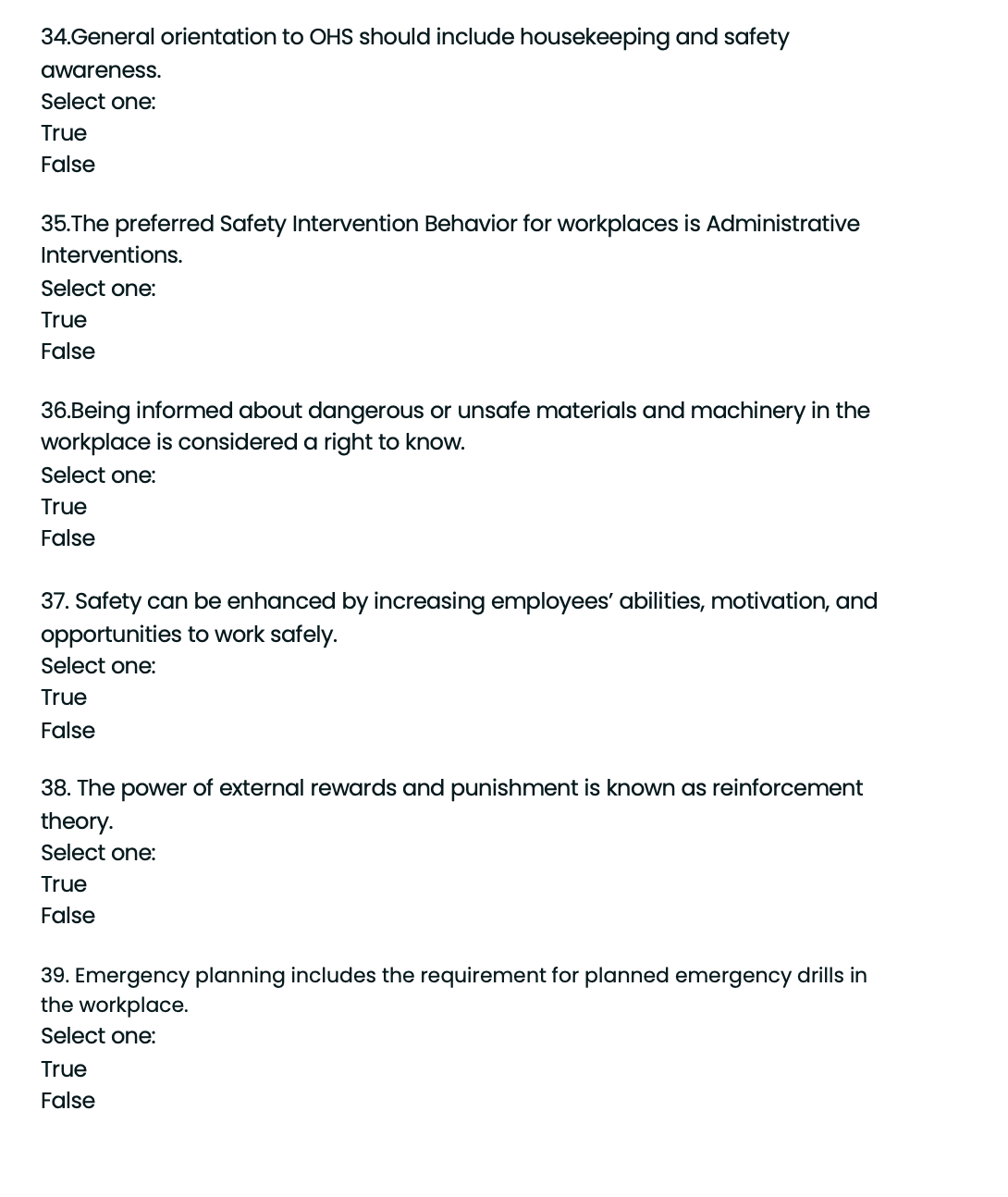

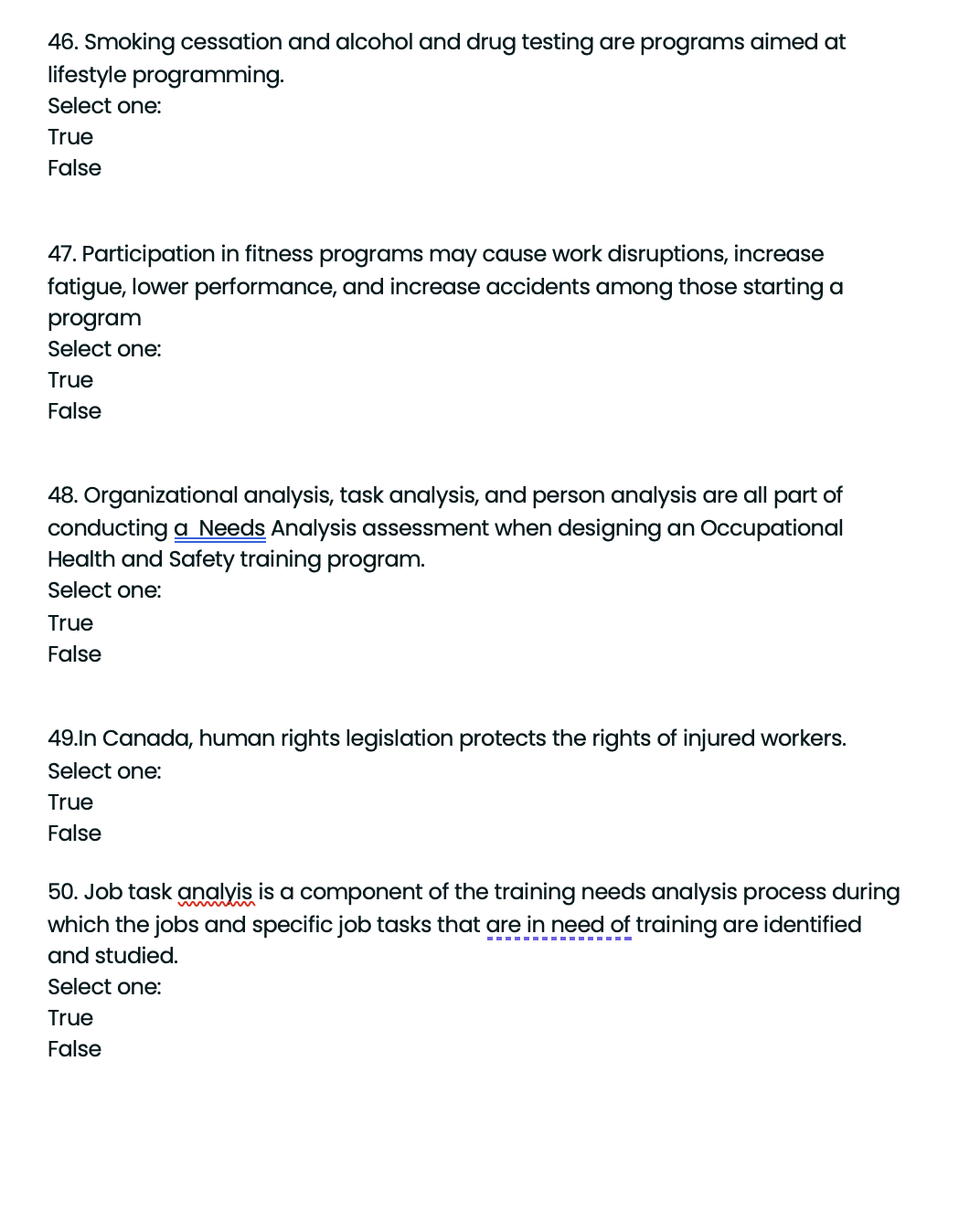
OCCYPATIONAL HEALTH AND SAFETY 1. What are the three basic rights that apply to all Canadian employees with regards to Occupational Health & Safety? a. Right to be present, right to particpate, right to refuse unsafe work. b. Right to particpate, right to refuse unsafe work, right to strike. c. Right to know, right to particpate, right to breaks. d. Right to know, right to particpate, right to refuse unsafe work. 2. Providing job instructions, performance aids, and job rotation are all a form of? a. Off the job training b. Asynchronous Learning c. Technology based training d. On the job training 3.The knowledge that is acquired via direct participation is considered to be what form of learning? a. Behavioural Learning b. Social Learning c. Motivational Learning d. Experiential Learning 4. When evaluating a training program all of the options below are effective EXCEPT? a. Focus groups b. Interviews c. Training surveys d. Performance Appraisals 5. Examples of safety behaviors include a. Proper use of hazard control systems b. Using personal protective equipment c. Safe work habits d. All of the above 6. The three classifications of safety programs are: a. Sociological, Administrative and Behavioral interventions. b. Engineering, Adminstrative, Behavioural Inventions c. Engineering, Administrative, Legislative Interventions d. Psychological, Sociological, Behavior Interventions 7. Safety behavior can be distinguished as: a. Safety participation and safety training b. Safety compliance and safety training c. Safety knowledge & safety compliance d. Safety compliance and safety participation 8. When someone persues a course of action that is important or enjoyable to them this is known as what theory of motivation? a. Reinforcement Theory b. Self-Determination Theory c. Goal Setting Theory d. Reward Theory " 9. Shared perceptions among employees and organizational stakeholders of the importance of workplace safety is known as? a. Adherence to policies b. Cultural norms c. Safety climate d. Organizational goals 10. An interactive collection of strategic organizational approaches and programs focused on identifying, achieving, and maintaining desires occupational health and safety targets is known as..... a. An Emergency Response Plan b. Occupation Health & Safety Management System c. A Safe Workplace d. Health and Safety Policies and Procedures 11. You have been asked to develop a company health and safety policy what are the elements you will want to include? a. A clear statement of the employers expectations of how people will follow all health and safety rules. b. Public stakeholder consultation, signature by human resources, and publicly posted in a high traffic area. c. Signature by Health and Safety Rep, and general statement on organizational health and safety committment. d. Signature by CEO, made publicly aavailable to all employees, outline the purpose of the program, and outline responsibilities of all staff. 12. The goals of emergency planning are: a. To review emergency plans post emergency to ensure refinements in light of new learning. b. Restoring operations back to normal and reducing fire damage. c. Reducing injuries and property damage, and restoring organizations to normal operations. d. To anticipate and plan for emergencies and put action plans into place. 13. During emergency preparedness, evacuation of staff, caring for the injured, and emergency response is known as what stage of planning? a. post-contact stage b. contact stage c. first response d. pre-contact stage 14. A fire triangle is created when.... a. fuel, health and oxygen meet. b. fuel, smoke, and oxygen meet c. fuel, heat, chemical reaction and oxygen meet. d. Heat, chemical reaction and flames meet. 15. Which stage of fire describes when fuel, oxygen, and heat are present and cause the heat to rise through a limited chain reaction? a. Incipient stage b. free-burning stage c. Smouldering stage d. Uncontrolled fire stage 16. A worker arrives on Monday morning and notices the electrical chord to their machine is frayed and causing sparks. The worker notifies the Supervisor immediately and the Supervisor tells the worker to return to the machine and that the machine is fine. The worker feels nervous about returning to the machine, what should they do next? a. Continue working on the machine. b. Leave the machine and go home immediately. c. Speak with the Supervisor and inform them they have the right to refuse unsafe work if they are asked to perform a task that they deem to be unsafe or are asked to use equipment that is not in good repair d. Call another co-worker over and ask their opinion. 17. First aid regulations specify that: a. The number of trained first aiders a workplace requires, the level of training required, and the amount and type of first aid equipment required. b. Distance to the nearest medical facility, how to contact emergency operators and the typed of supplies you are required to have. c. The instructions for giving first aid and emergency repsonse to workers. d. Instructions on how to use first aid supplies. 18. All of the following are benefits of accident investigation EXCEPT? a. Determines direct causes. b. Provides for disciplinary meansure for breaking safety rules. c. Prevents similiar incidents d. Promotes safety awareness among employees. 19. What best influences the investigation of workplace accidents/incidents? a. The experience of the worker b. The experience of the accident invetigator c. Timing and the appropriate tools. d. Timing and Severity 20. A general approach to accident investigation involves: a. Investigate the accident with a partner and then write your report to management, b. Secure the scene, ask questions then allow workers to tell you their story before writing your report. c. Secure the scence, gather evidence, analyze information, report information, make recommendations, follow up d. Have the worker involved in the accident write a report for management to review. 21. During an accident investigation when asking questions, asking witnesses what tools, or equipment may have been involved is an example of? a. Human Factor b. Situational Factor c. Administrative Factor d. Environmantal Factor 22. The legislated responsibility of employers to accommodate workers who are attempting to return to work following an injury or illness via changes in job tasks and/or the work environment to enable workers with a temporary or permanent disability to perform work productively is known as? a. Duty to accomodate b. Disability Management c. Return to work program d. Occupational Health and Safety Program 23. When designing a training program, the Instructional Systems Design (ISD) Model of Training incorporates which three parts? a. Physical Demands Analysis, Needs Analysis, Training Evaluation b. Training Design and Delivery, Needs analysis, Physical Demands Analysis c. Physical Demand Analysis, Functional Abilities Form, Training design d. Meeds Analysis, Training design and delivery, Training Evaluation 24. The aspect of human rights legislation that means employers must accommodate the needs of a disabled worker unless the necessary modifications would lead to health and safety difficulties or present unsustainable economic or efficiency costs is known as? a. Duty to accomodate b. Occupational Health and Safety Program c. Disability Management Program d. Undue hardship 25.A type of light-duty accommodation where job demands slowly increase until the workers are performing the full requirement of their pre-injury jobs is known as? a. Gradual work exposure b. Integrated Return to Work c. Modified light duty work d. Light Duty Work 26. Modifications to the arrangement of work that promote early and safe return to work for injured, ill, or disabled workers is known as? a. Return to Work Planning b. Graduated Return to Work c. Machine guarding d. Workplace Accomodation 27. Examples of workplace wellness initiatives include: a. Company values and mission statements. b. Company policy and procedures. c. Family friendly policies and health promotion programs. d. Company pay and benefits. 28. When workers work full-time hours in fewer days this is known as? a. Flexplace b. Job sharing c. compressed work-week d. Job splitting 29. An organizational analysis should: a. All of the above. b. Examine resources, strategy, and environment in order to assess the organization's support for training c. Identify the health and safety areas that need knowledge and skills improvement and that may be targets for a training program d. -Highlight any constraints that may limit the success of a training program before training is designed and delivered 30. A safety climate refers to: a. Employees' shared perceptions of the importance of safety in the workplace b. Relates to perceptions about safety-related policies, procedures, and practices that are shared by all stakeholders in the organization c. Examination of the organization's safety climate is one way to determine the extent of organizational support for a health and safety training program d. All of the above 31. A legislated training program in the handling of potentially hazardous chemicals in the workplace that ensures Canadian workers recognize hazardous materials and are knowledgeable in emergency procedures following a chemical spill is called? a. Hazard Analyis b. Chemical Training Program c. Workplace Chemical Inventory d. Workplace Hazordous Materials Information System 32. Training that targets specific actions is a form of social learning. Select one: True False 33.Safety Behaviour can be defined as workplace behaviours that lead to the safe performance of a particular job. Select one: True False 34.General orientation to OHS should include housekeeping and safety awareness. Select one: True False 35. The preferred Safety Intervention Behavior for workplaces is Administrative Interventions. Select one: True False 36.Being informed about dangerous or unsafe materials and machinery in the workplace is considered a right to know. Select one: True False 37. Safety can be enhanced by increasing employees' abilities, motivation, and opportunities to work safely. Select one: True False 38. The power of external rewards and punishment is known as reinforcement theory. Select one: True False 39. Emergency planning includes the requirement for planned emergency drills in the workplace. Select one: True False 40. A key element in most health and safety programs include hazard recognition, assessment and control. Select one: True False 41. Investigative reports should consider the factors most closely associated with the cause of the incident. Select one: True Fals 42. Unsafe acts in the workplace are typically a product of organizational culture and ineffective supervision. Select one: True False 43. Indicators of program success for Disability Management programs include improved quality of life for the worker. Select one: True False 44. A standardized evaluation of the physical and cognitive demands of a job completed by a person familiar with the job is known as a functional abilities assessment. Select one: True False 45. Barriers to returning an injured worker to the workplace can include the length of time a worker has been off of the job. Select one: True False 46. Smoking cessation and alcohol and drug testing are programs aimed at lifestyle programming. Select one: True False 47. Participation in fitness programs may cause work disruptions, increase fatigue, lower performance, and increase accidents among those starting a program Select one: True False 48. Organizational analysis, task analysis, and person analysis are all part of conducting a Needs Analysis assessment when designing an Occupational Health and Safety training program. Select one: True False 49.In Canada, human rights legislation protects the rights of injured workers. Select one: True False 50. Job task analyis is a component of the training needs analysis process during which the jobs and specific job tasks that are in need of training are identified and studied. Select one: True False
Step by Step Solution
★★★★★
3.31 Rating (145 Votes )
There are 3 Steps involved in it
Step: 1
The detailed answer for the above question is provided below 1 The correct answer is d Right to know right to participate right to refuse unsafe work These are the three basic rights that apply to all ...
Get Instant Access to Expert-Tailored Solutions
See step-by-step solutions with expert insights and AI powered tools for academic success
Step: 2

Step: 3

Ace Your Homework with AI
Get the answers you need in no time with our AI-driven, step-by-step assistance
Get Started


